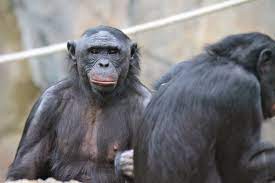I have written about Bonobos in the past, I hope that readers are aware of this species. In brief, Bonobos (often known as Pygmy chimpanzees) are a separate great ape species. These two species split about 1 million years ago as the Congo river formed and became an impenetrable boundary between them intermixing again.

Found only in the DRC and the last of the great ape species to be discovered, Bonobos should be of great interest to humans.
This is for many reasons. Bonobos are an incredibly peaceful species, dealing with conflict and stress through sexual behaviour rather than violence. Bonobos are considered far more intelligent than Chimpanzees in many different ways.
Unfortunately, as they only live in the Democratic republic of the Congo, and their forest home is being cut down they are increasingly under threat. Another big threat is the bushmeat trade – although considered a delicacy in places, Bonobos are so similar to humans that eating them causes similar threats of illness to cannibalism. Dangers of bushmeat are not restricted to primates, but encompass many of the species that live in these forest homes.
This is where orphaned bonobos come in. In need of many of the same things that baby and toddler humans require, it takes a great deal of work to bring up a Bonobo and to teach them enough to survive and thrive in the wild.
The wild Bonobo population certainly does not exceed 50,000 and there are fears that it could be as low as 15,000. As such these reintroductions are essential, and this must be the second of many. I very much hope to visit this part of Africa at some point (preferably as soon as possible)
Bonobos hold a particular fascination for me, and it seems that with not to huge an amount of money, much of their future could be guaranteed. I certainly hope that they still exist for my grandchildren and great grandchildren to trek to see these animals.











